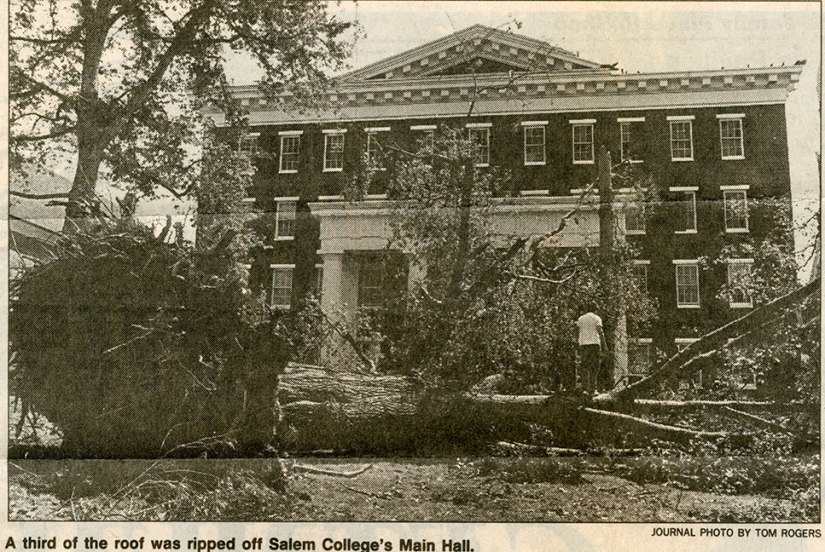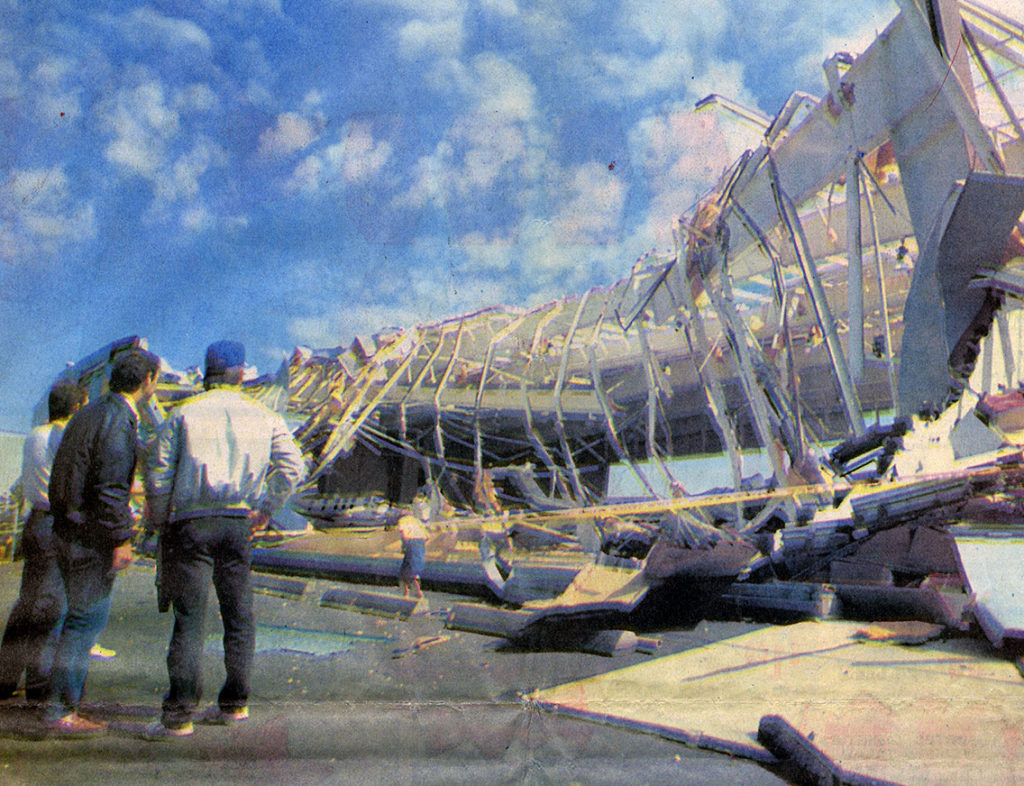Tornadoes in the south are especially dangerous. Rolling hills and thick tree lines conceal horizons, blocking key vantage points for tornado spotters. Unlike the Midwest, where you can see a tornado miles in advance, killer twisters have a habit of sneaking up on you in Dixie. The North Carolina piedmont is no exception. Centuries aged oak trees and pines line the Piedmont terrain that varies between 500 to 1,000 feet – just enough to block your view of what’s up ahead. In a particular cruel twist of fate, most southern tornadoes occur in the dead night, aggravating an already dire situation. In 1989, only half of all tornadoes were preceded with a warning. And if you were lucky enough to get a warning, you might get a five minute head start. This all made for a ‘perfect storm’ that unleashed the infamous 1989 Winston-Salem tornado outbreak.

May 5, 1989 was a Friday in Winston-Salem, N.C. Known as “Camel City,” due to the city’s cozy history with the tobacco industry, the budding metropolitan was becoming a major player in the state’s growing economy. Still basking the heyday of modern manufacturing, the city was also a cultural epicenter for the arts and music, and supported several public and private colleges. Unlike other southern cities that were denuded of vegetation and remnants of its early settlers, relics of Winston’s provenance served as daily reminders that townspeople had not forgotten their roots as they were poised to enter a new age. You could say that Winston was a quintessential American city. It was as quaint as it was bustling. Unlike other major metropolitans, Winston was small enough to escape the daily dangers of urban living, including a high crime rate. Shielded by mountains from the west, Winston was located far inland enough to escape dangerous storms and hurricanes. Yet this prevailing sense of peace would be forever shattered when three tornadoes narrowed their sights on this unsuspecting town.
“I believe I’m in a tornado here at Hanes Mall,”
The 1989 Winston-Salem tornado outbreak would forever change how locals viewed the world. Although tornadoes were not completely unheard of in the Carolinas, they were still rare. This of course changed when three twisters touched down within minutes of one another in this small North Carolina city. Just after nightfall, phone lines at the county’s emergency dispatch center began ringing off the hook. Tree branches began to snap and the winds began to howl at deafening pitches, as the city quickly descended into complete darkness. Meteorologists couldn’t believe what they were seeing on the radar. The classic and unmistakable sucker-punch hook a tornado storm cell flashed across their monitors. Was this really happening in North Carolina? Were multiple tornadoes about to touchdown? Didn’t this sort of thing only happen in Texas or Alabama?
“I just remember seeing that cell on our radar coming down I-40,” said Paul Dellegatto, who was 29 and working as a meteorologist for WXII-TV. “It was what looked to me to be a classic tornado signature on the radar. That was the first time I was exposed to a big Southern tornado. I remember looking at the path of it, and I was saying to myself, I hate to be wrong and over-warn people but this is too big a deal not to jump on it.”
Anchorman and forecasters frantically interrupted television broadcasts to urge residents to seek cover immediately. “Get into washing machines or anything that you can,” instructed on frazzled meteorologist. Reports of funnel-shaped clouds had begun to flood TV stations and police departments alike. Even seasoned police officers, who routinely investigate violent crimes, including homicides and grisly crime seasons appeared visibly shaken. “I believe I’m in a tornado here at Hanes Mall,” one officer said over the radio. “My car is rocking,” said another. For several minutes, the city remained transfixed and frozen. As the storm continued its unprecedented warpath, locals simply waited for the ax to fall as they hopelessly awaited whatever might come next.

1989 Winston-Salem tornado outbreak underscores importance of superior protection

Although the tornado outbreak was over in a matter of minutes, it must’ve felt like hours for the beleaguered city. As the three tornadoes continued to unleash unprecedented destruction on the city, locals could only pray that their loved ones were safe. They would have to wait until morning to survey the destruction and check on their neighbors. It would become the longest night of summer that residents would ever endure. Unfortunately, the storm’s worst had yet to materialize. One of the EF-2 tornadoes demolished an aircraft hangar at the iconic Smith Reynolds Airport. The true magnitude of the storm’s destruction magnitude was on full display. It was one thing for high winds to break a few tree limbs or down power lines, but to have the ability to crumple solid sheets of metal and steel? Altogether, the storms packed a punch of windspeeds of 112 to 157 miles per hour. Although 50 people were injured, no one was killed during this chaotic tornado outbreak. It was truly a miracle.
1989 was a different time. Early storm warnings simply didn’t exist. Tornado sirens typically didn’t sound until it was far too late. The term “tornado shelters” was still not part of the American lexicon. Storm cellars or a basement (and maybe a bathtub if you were truly desperate) remained the best bet against riding out a story. Thankfully, times have changed. Advances in meteorology can give residents several minutes of advance warning in the event of a storm. Upgrades in the tensile strength and malleability of steel make safe rooms and tornado shelters now accessible to the general population. U.S. Safe Room has also emerged a forerunner in storm protection technology. A U.S. Safe Room® Bolt-Together Safe Room Kit features easy-to-install modular steel panels that can be fitted to closet space, or simply convert a part of any larger room into a fully secured safe room tornado shelter, storm safe, or multi-use safety storage. Our modular safe room bolt-together kits can be customized to your specific needs. Don’t wait until after a life-threatening event, contact us today and protect yourself from storms, intruders, and natural disasters. Be prepared with US Safe Room.






